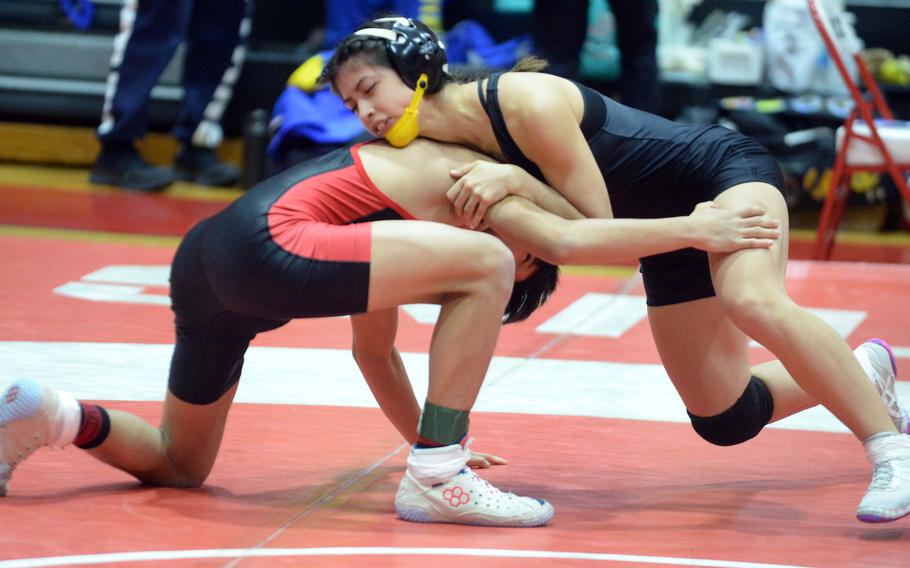
American School In Japan sophomore Serena Koslow is among the athletes and coaches who are hoping for a Far East wrestling tournament girls division soon. (Dave Ornauer/Stars and Stripes)
YOKOSUKA NAVAL BASE, Japan — Serena Koslow came off the mat, beaten but unbowed.
The American School In Japan sophomore had just lost 17-8 in a first-round 114-pound bout against Nile C. Kinnick’s Gavin Caddali. It was a back-and-forth duel, with Koslow at times coming close to wrenching Caddali’s shoulders to the mat.
She said that while she’s happy to be wrestling — her three older brothers are former Far East tournament champions — she would enjoy it more if boys and girls wrestled in separate divisions.
“I’d definitely feel more encouraged,” Koslow said during Saturday’s 31st Kinnick Invitational “Beast of the Far East” tournament. “It would give me more confidence, knowing I could win more matches.”
Though DODEA-Pacific does not yet offer wrestling just for girls, the sport is growing by leaps and bounds in the States, statistics show.
And for the first time, a team entirely comprised of girls at Seisen International will compete in a Kanto Plain Association of Secondary Schools event Saturday at St. Mary’s. Seisen, an all-girls Catholic school, will compete in exhibitions against other girls entered.
“There is a lot of interest,” said Shu Yabui, a former three-time Far East champion who coaches both St. Mary’s and Seisen’s teams.
“Far East (DODEA-Pacific) and the Kanto Plain need to get going. We are at the threshold where it will be necessary to split boys and girls.”
Over the last 25 years, more and more girls have been coming out for wrestling on DODEA-Pacific teams, not quite mirroring the growth in the States, but increasing gradually.
Janine Kunsch of Robert D. Edgren is believed to be the first female wrestler in DODEA-Pacific, in 1999 at 122 pounds. Edgren became one of the leading schools with female wrestlers in the practice room.
Emily Albonetti of Osan took sixth place in 2008, becoming the first girl to score team points during a Far East tournament.
Yurie Tanaka of Zama followed two years later with a fifth-place finish. Then last year, Kubasaki’s Gwen Pantaleon became the highest-finishing female wrestler in a Far East tournament, taking third at 101 pounds.
This season, Koslow is one of two girls on ASIJ’s varsity. Seisen has 11, Kinnick has 10, Kubasaki has seven, Kadena has four, Zama and E.J. King three each and Yokota two.
Logically, the next step would be to separate the two genders, given the growth in the U.S. Hawaii was the first state to sponsor girls wrestling, in 1998, and the growth began from there.
Flowrestling.org shows 33 states represented in its 2023-24 preseason high school rankings, with Texas, Tennessee, Oklahoma and California having four different teams in those rankings. From 2022 to 2023, the number of girls wrestlers increased from 35,653 to 52,406.
“If Seisen can get 11” girls out for wrestling, “then I’m sure every school can get at least 10,” Yabui said.
Though Kanto is taking the first step on Saturday, there are still hurdles for DODEA-Pacific to clear.
For one, none of DODEA-Pacific’s districts in Japan, Korea and Okinawa sponsor wrestling strictly for girls. Guam’s Interscholastic Sports Association has had girls wrestling for more than 15 years, but Guam High is the only DODEA entity on Guam.
And if DODEA-Pacific was to add girls wrestling to its tournament slate, it would have to add another Far East in a boys sport to keep the number of Far Easts per gender equal, DODEA-Pacific officials said.
But to hear DODEA-Pacific coaches say it, they’d be all for it.
“I am 100-percent on board for providing as many opportunities for as many student-athletes as possible,” Kubasaki sponsor David Wray said. “If it means kicking in a few extra bucks, then I’m all for it.”
Joey Wood used to wrestle at Kinnick and is now the third-year coach at Kadena. He feels if DODEA was to offer it even on a provisional basis, the number of female wrestlers would increase dramatically.
“I’m all for it,” Wood said. “I think more girls would come out if they knew there was girls wrestling.”
While almost every DODEA-Pacific wrestling event this season has been co-ed, one in-season tournament at Christian Academy Japan did have enough girls – eight – to form one all-girls division. Koslow took first place in that event.
A girls Far East division might give her a chance to match her older brothers, Shane in 2017, Austin in 2019 and Warren in 2020, as a fourth sibling to extend what is already a Far East tournament family record.
“I don’t think there are enough girls to make it happen” right now, but to have wrestling just for girls “would really be cool,” Koslow said.
“I hope it can happen in the next two years,” Yabui said.